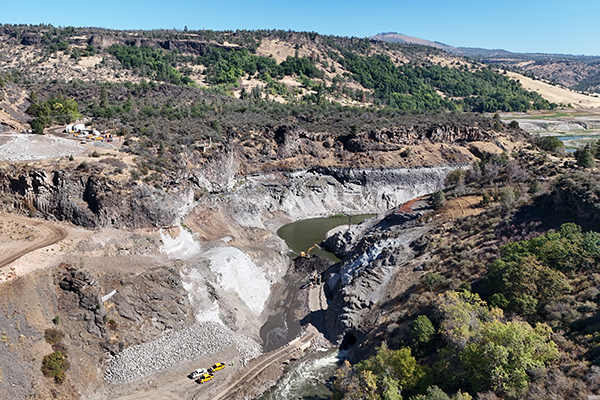
Klamath River Renewal Project
Cliente
Kiewit Infrastructure West Co.Ubicación
California and Oregon, USAAspectos destacados
- Largest dam removal and river restoration project in U.S. history
- Detailed design for the removal of four aging hydroelectric dams
- Dam modifications design
- Reservoir drawdown planning
- Habitat restoration
- Road, bridge, and culvert infrastructure improvements

Overview
Considered the largest dam removal and river restoration project in U.S. history, the Klamath River Renewal Project involved the removal of four hydroelectric dams along the Klamath River in Oregon and California to restore volitional fish passage to historic habitat and spawning grounds.
Knight Piésold, as the lead designer for the prime contractor Kiewit Infrastructure West Co. (Kiewit), developed innovative designs for safe dam decommissioning, reconnecting over 400 stream-miles of salmon habitat.
The Challenge
The Klamath River Renewal Corporation (KRRC), a nonprofit organization established under the amended Klamath Hydroelectric Settlement Agreement, led the effort to re-establish the Klamath River's natural vitality. Signatories included state and local governments, Tribal Nations, the former dam owner, irrigators, and conservation groups.
The project was distinct in its scale, complexity, and requirement to remove multiple dams simultaneously while managing environmental impacts, dam safety concerns, and diverse stakeholder interests, adhering to strict timelines and addressing unforeseen issues with century-old structures.
Our Approach
Knight Piésold worked closely with Kiewit, under a progressive design-build (PBD) contract, with the project owner KRRC. The PBD delivery model allowed for early collaboration and problem solving by the project owner, contractor, and designer.
Knight Piésold developed comprehensive solutions to safely decommission four aging hydroelectric dams: J.C. Boyle, Copco No. 1, Copco No. 2, and Iron Gate. The work included designing construction access routes, developing reservoir drawdown using new or refurbished low-level outlets, developing staged removal for dams and ancillary facilities, creating on-site material disposal strategies, and designing erosion protection for the restored river channel through the former dam sites.
With the oldest dam over 100 years old, the project faced unanticipated challenges due to unknown conditions of the aging facilities. Knight Piésold was able to adapt the designs and provide timely guidance to address issues, such as unconsolidated material beneath tunnel slabs, unexpected dam material composition, and fractured bedrock in access road areas. Some examples include:
- Retrofitting the Iron Gate dam historic diversion tunnel used during dam construction with energy dissipation and venting structures.
- Designing an innovative “lake tap” outlet through the base of the concrete dam at Copco No. 1 when the old tunnel was inaccessible.
- Providing guidance on sensitive placement of dam zone materials in the gully disposal area of J.C. Boyle dam to ensure the stability of the placed materials when the excavated materials were found to be different than anticipated.
- Providing guidance on adjustments to the road prism geometry for Copco No. 1 and Copco No. 2 dams when the bedrock was found to be more fractured than anticipated.
- Developing a flexible staging plan for removal of the two earthfill embankment dams to accommodate seasonal hydrologic conditions. This plan was updated during the removal year based on actual conditions, allowing for earlier and more efficient dam removal while ensuring safety and minimizing environmental impacts.
The Results
The Klamath River Renewal Project has successfully restored over 400 stream-miles of salmon habitat, with adult chinook salmon returning within weeks of dam removal. The anticipated legacy of this project is the restoration of a vital river system, benefiting local communities and promoting the sustainability and resilience of both the hydroelectric industry and the ecosystems it impacts. The project provides a blueprint for future decommissioning efforts.
KRRC and Swiftwater Films have released the following videos that show breaches of the four dams:
- Dam breach video of the J.C. Boyle dam
- Dam breach video of the Copco No. 1 dam
- Timelapse video of the dam removal of the Copco No. 2 dam
- Video of the modified diversion tunnel opening at the Iron Gate dam
The Oregon Public Broadcaster released the following footage of each dam site before and after:
For more information about the project, visit KRRC’s project website.
Technical Papers
- Drawdown Modelling of Four Reservoirs on the Klamath River to Support Hydroelectric Facility Decommissioning
- Design of Dam Modification for Reservoir Drawdown, River Diversion and Dam Removal of the Copco No. 1 Dam
- Optimization of the Iron Gate Dam Historic Diversion Tunnel Using CFD Analysis to Support Reservoir Drawdown
- Dam Breach Analysis Used for Designing the Final Breach of the Iron Gate Dam
Awards
- Award of Excellence, Environmental Stewardship Category, 2025 ACEC National Awards
- Award of Merit, Natural Resource & Habitat Category, 2025 ACEC-BC Awards for Engineering Excellence